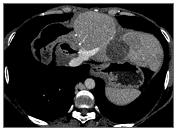Due to the range of treatment options available to treat cancer, a multidisciplinary team (MDT) approach is usually needed to assess each case. Until recently surgery had been the only option for treating cancer of the liver and pancreas however, due to the complexity and proximity of these organs to each other and other vital organs, surgery is often simply not viable. Professor Leen illustrates the potential for Nanoknife with this highly appropriate case study of his patient Mrs MR.
NanoKnife Case Study
Mrs MR was a 38 year old lady who had been previously operated on but who had worsening and highly involved liver cancer. This was a very serious and complex case. The full medical description of her condition was that she had “recurrent progressive liver metastases, a year after having had a previous right hepatectomy for rupture of the adrenocortical liver metastases and an attempt to repeat a resection of the new liver metastases failed”.
Local Ablative Therapy - no other treatment option
At the time, Mrs MR was clearly not responding to the usual choice of drugs, namely, systemic therapy with Mitotane. It was therefore decided by the multi-disciplinary team (MDT) to proceed to a more direct approach to remove the tumour or "local ablative therapy", as there was no other treatment option.
The main challenge was to remove a 6.5 cm metastasis in an area of the liver that lay under the lung "the left sub-diaphragmatic area"; it was also under the left ventricle of the heart and so was alongside the left hepatic vein and one of the main body veins - the inferior vena cava. There are a number of ways that surgeons can ablate material and the first attempt at ablating this large metastasis was with conventional radiofrequency ablation (RFA), but due to the inadequacies of RFA in this situation and a lack of precision with this technology it was unfortunately not possible to completely remove all the tumour material.
The main challenge was to remove a 6.5 cm metastasis in an area of the liver that lay under the lung "the left sub-diaphragmatic area"; it was also under the left ventricle of the heart and so was alongside the left hepatic vein and one of the main body veins - the inferior vena cava. There are a number of ways that surgeons can ablate material and the first attempt at ablating this large metastasis was with conventional radiofrequency ablation (RFA), but due to the inadequacies of RFA in this situation and a lack of precision with this technology it was unfortunately not possible to completely remove all the tumour material.
Multiple Needle Electrodes into the Ablation Zone
As a result, it was decided to try to use NanoKnife. This involved the placement of multiple needle electrodes into the ablation zones to cover the tumour itself plus the precise desired surgical area. Despite the location of the metastasis being so close to the heart and major blood vessels, the procedure was successful and uneventful. Mrs MR made a full recovery and was discharged the following day.
Complete Recovery
A subsequent CT scan performed six weeks later showed significant involution (reduction in size) of the ablated zone with approximately 50% reduction in size (Figures 1A & 1B). 
Perhaps more importantly, all blood vessels that had been supplying the tumour had been destroyed (this is known as devascularisation, which is a critical step in ensuring that the tumour cannot grow back again). Fifteen months later and at follow-up there had been no recurrence, or return of the tumour. 
For further information on the author of this article, Professor of Radiology, Prof Edward Leen, please click here.
A fluid that transports oxygen and other substances through the body, made up of blood cells suspended in a liquid.
Full medical glossary
Abnormal, uncontrolled cell division resulting in a malignant tumour that may invade surrounding tissues or spread to distant parts of the body.
Full medical glossary
The abbreviation for computed tomography, a scan that generates a series of cross-sectional x-ray images
Full medical glossary
The strong muscular sheet separating the chest and abdominal cavities
Full medical glossary
Relating to the liver.
Full medical glossary
The large vein that carries de-oxygenated blood from the lower half of the body to the heart.
Full medical glossary
A large abdominal organ that has many important roles including the production of bile and clotting factors, detoxification, and the metabolism of proteins, carbohydrates and fats.
Full medical glossary
Secondary tumours’ that result from the spread of a malignant tumour to other parts of the body.
Full medical glossary
The spread of a malignant tumour to other parts of the body.
Full medical glossary
Relating to a group of healthcare professionals with different areas of specialisation.
Full medical glossary
A gland behind the stomach that produces digestive enzymes and the hormones insulin and glucagon, which together regulate glucose levels in the blood.
Full medical glossary
A glandular organ that secretes digestive enzymes and hormones.
Full medical glossary
Continuously increasing in extent or severity.
Full medical glossary
The surgical removal of part of the body.
Full medical glossary
Affecting the whole body.
Full medical glossary
An abnormal swelling.
Full medical glossary
Relating to blood vessels.
Full medical glossary
The process of blood flowing through the area.
Full medical glossary
A blood vessel that carries blood towards the heart.
Full medical glossary
Either of the two lower chambers of the heart, or any of the four cavities within the brain.
Full medical glossary
Capable of survival.
Full medical glossary




